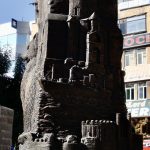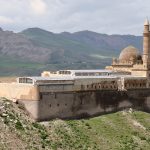Roughly delineated by an imaginary line drawn south from Trabzon on the Black Sea coast through Erzincan to Tunceli and then heading east to Doğubayazıt, North-East Anatolia could hardly be more different from the South-East. While that is primarily an area of semi-desert, mountainous only around its far south-eastern corner, much of North-East Anatolia is an area of greenery with the soaring Kaçkar Mountains acting as a barrier between it and the Black Sea.
Of the big north-eastern towns, Erzurum basks in a reputation as Turkey’s coldest city but also boasts some fine Selçuk monuments, while Kars is often unfairly dismissed as a mere base for visiting the abandoned Armenian city of Ani despite a heritage of fine Russian buildings. A staple on tour itineraries, Doğubayazıt crops up countrywide in posters of the dramatic İshak Pasa Palace.
The region’s borders with Georgia, Armenia, Nakhichevan and Iran bring it all sorts of unexpected cultural quirks, but only the Georgian border is truly open to all-comers. You can’t currently cross overland to Armenia, and entering Nakchivan, an exclave of Azerbaijan, is of limited benefit because the only way to proceed to Baku for the time being is by plane. The Iranian border is open to those with visas but acquiring these is rarely easy.
Getting there
North-east Anatolia is so far from İstanbul and Ankara that it’s best to short-circuit the journey and fly to Erzurum, Kars or Doğubayazıt (or to Trabzon or Van if you want to work your way down from the Black Sea or up from Lake Van).
Once there you’ll find a good network of buses and minibuses connecting the main settlements although they don’t always operate quite like clockwork. Although the roads between the main towns are excellent, this is an area that also offers some wild and hairy mountain drives best not attempted by the inexperienced. Expect roadside service stations to be fewer and more lacklustre than in the west.
Facts must be faced, and sadly Erzurum is not a particularly beautiful town, its main street having been cobbled together with no thought for overall appearance. That said, this is a town with more than enough to distract you for a day or so, starting with the remains of a castle dating back to the fourth century and proceeding through the beautiful Selçuk Çifte Minare Medrese and the adjoining Ulu Cami before arriving at the Yakutiye Medresesi which now accommodates an excellent small museum of Turkish and Islamic art. Tucked in the back streets the 16th-century Rüstem Paşa Çarşısı houses many small shops selling jewellery and tesbihs (rosaries) carved from oltutaşi, locally mined obsidian.
Old Kars is a wonderful place of wide streets lined with single-storey stone houses painted in pastel colours, leftovers from the days of the late 19th-century Russian occupation. Like Erzurum, the town boasts a magnificent castle that overlooks a river whose banks are dotted with the crumbling remains of old hamams. Between these two areas the enormous Evliya Mosque overshadows the tiny 10th-century Armenian church of the Twelve Apostles that has also been turned into a mosque. In the Kar’s Otel, Kars boasts a rare-for-these-parts boutique hotel housed in one of the more imposing of the Russian mansions. Kars’ cuisine has also been influenced by its border location – – look out for piti, a curious dish served in a cup that turns out to provide a filling two-course meal.
Forty-five km east of Kars and right on the Armenian border, Ani is a world heritage site. Huge brown and black chequered walls once ringed an Armenian capital that, in its 10th-century heyday, was home to 100,000 people. They were finally driven out by the armies of Tamerlane in the 14th century and the town never recovered. If you visit on a sunny day when there are no tour groups present it’s one of the most evocative places in Turkey, not least for the beauty of its setting on a spur surrounded by rivers and overlooking the troubled border. With your own car you could also explore some of the surrounding villages such as Oğuzlu where the remains of other huge Armenian churches stand forgotten in farmyards.
Most people tackle the Kaçkar Mountains from the Black Sea side but if you want to approach from the south, pretty little Barhal (Altıparmak), surrounded by woodland and dominated by the remains of an old Georgian church, makes the perfect base. The owners of several small pensions can organise treks across the mountains to Çamlıhemşin with horses to carry your luggage.
Doğubayazıt is best known for the iconic İshak Paşa Palace which stands in splendid isolation on a bluff some 6km south of town. The 17th and 18th-century handiwork of Çolak Abdi Paşa and his son İshak Paşa, it’s an extraordinarily elaborate mix of mosque and dwelling place with a wonderful view out over the surrounding plain. The town itself is nothing to write home about, although it’s fun poking about in the shopping mall to see what must-have Iranian goods are on sale. Local tour companies offer trips to see a huge crater left by a meteor strike near the Iranian border and to one of several local sites that claim to be the last resting place of Noah’s Ark.
At 5137m, Mt Ararat is Turkey’s highest mountain and dominates the landscape for km around. Some believe that this was where Noah’s Ark finally came to rest after the Flood and the mountain is also hugely important to the Armenians. After years in which it was not possible to climb it, permits are now being issued once again although you need to plan ahead (think six weeks) and go through a travel agency to be sure of getting one. The trip up and back takes best part of three days. It’s a strenuous climb but doable, allegedly, by anyone of normal fitness.
Pressed up against the Georgian border, this lovely small lake receives relatively few visitors and is especially appealing in May and June when the fields glow with wild flowers. If you continue on to the end of the road you will come eventually to the spectacular Şeytan Kalesi (Satan’s Castle) overlooking an isolated gorge.
Midway between Ardahan and Artvin, Şavşat is the kicking-off point for visiting the curiously-named Karagöl Sahara National Park. Right beside the pretty Meşeli Karagöl lake is the Şavşat Karagöl Otel, one of Turkey’s remotest places to stay.
The history of the north-east corner of north-east Anatolia is a bewildering mish-mash involving long-lost Georgian and Armenian dynasties who sometimes seem almost interchangeable. The Georgians, though, left some extraordinary monuments in the shape of huge churches topped with domes that would once have been decorated with colourful frescoes. Their remains can mostly be found in the valleys running off the road between Erzurum and Artvin but can be tricky to get to without private transport; if you only have time to visit one it should probably be İşhan or Öşkvank. On the way there or back you can stop at Tortum Lake into which tumbles the country’s tallest waterfall.

